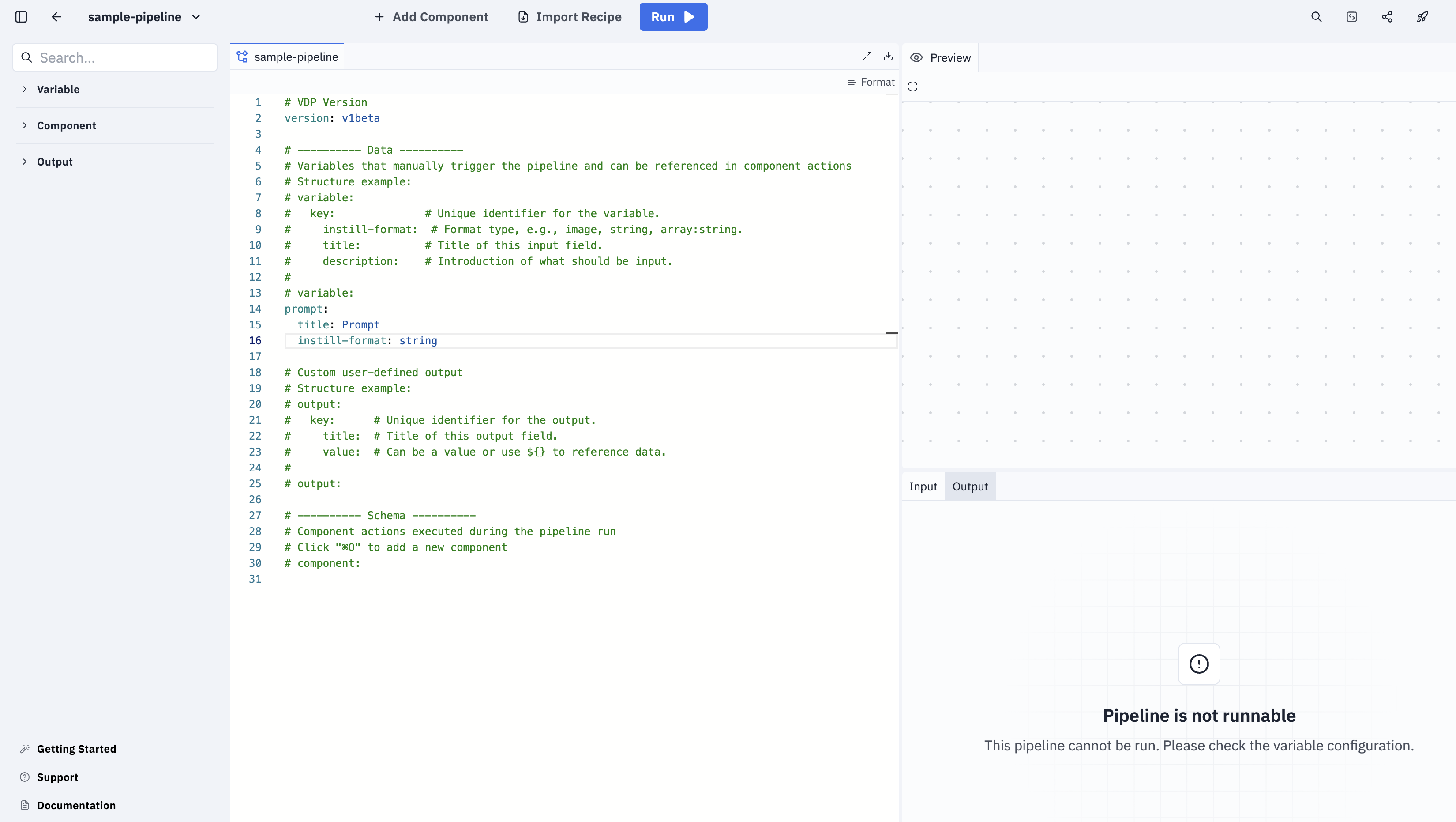Create Pipeline
Pipeline in Instill Core is a deployable resource that functions as an API service. Designed specifically for unstructured data ETL, it provides a flexible and powerful way to build data workflows. At its core, a pipeline recipe defines a directed acyclic graph (DAG) workflow that can be executed end-to-end via manual triggers, remote events, or scheduled runs.
Pipeline offers multiple methods for creating a pipeline, including HTTP and gRPC APIs, the Python and TypeScript SDKs, and Console.
Create Pipeline via API
curl -X POST 'http://localhost:8080/v1beta/namespaces/NAMESPACE_ID/pipelines' \
--header "Content-Type: application/json" \
--header "Authorization: Bearer $INSTILL_API_TOKEN" \
--data '{
"id": "PIPELINE_ID",
"description": "A brief description of your pipeline",
"rawRecipe": "#The YAML recipe of your pipeline"
}'from instill.clients import init_pipeline_client
pipeline = init_pipeline_client(api_token="INSTILL_API_TOKEN", url="http://localhost:8080")
pipeline.create_pipeline(
namespace_id="NAMESPACE_ID",
pipeline_id="PIPELINE_ID",
description="A brief description of your pipeline",
raw_recipe="#The YAML recipe of your pipeline",
)
pipeline.close()NAMESPACE_ID refers to the user or organization ID, and PIPELINE_ID is the pipeline ID. The resource ID must start with a lowercase letter (a–z) or an underscore, followed by up to 31 characters that may include lowercase letters (a–z), digits (0–9), hyphens, or underscores. The total length must be between 1 and 32 characters.
INSTILL_API_TOKEN is the API token that should be created in advance.
Pipeline Object
In the Create Pipeline and all APIs in Manage Pipelines, all endpoints follow a consistent structure for request and response bodies. Below are the key fields:
id: The pipeline's unique identifier.uid: The immutable UID of the pipeline.name: The full resource name of the pipeline.description: A brief description of the pipeline.readme: A README for the pipeline.rawRecipe: The pipeline's recipe in YAML format. For more details, see Pipeline Recipe.recipe: The JSON representation of the YAML recipe (read-only).sharing: The sharing settings for the pipeline. For more information, refer to Share Pipeline.releases: Associated releases of the pipeline. For more information, refer to Release Pipeline.stats: Statistical data related to the pipeline.
For additional details, please refer to the API reference.
Example Pipeline Object:
{
"name": "users/test/pipelines/sample",
"uid": "fd9d9e8f-8533-45ea-b8c9-f4029d9ad1af",
"id": "sample",
"description": "This is a sample pipeline",
"recipe": {
"version": "v1beta"
},
"createTime": "2024-10-01T02:54:18.594935Z",
"updateTime": "2024-10-01T02:54:18.594935Z",
"deleteTime": null,
"sharing": {
"users": {
"*/*": {
"enabled": true,
"role": "ROLE_EXECUTOR"
}
},
"shareCode": null
},
"metadata": {},
"ownerName": "users/test",
"releases": [],
"readme": "",
"permission": {
"canEdit": true,
"canTrigger": true,
"canRelease": false
},
"owner": {
...
},
"dataSpecification": null,
"tags": [],
"stats": {
"numberOfRuns": 0,
"lastRunTime": "0001-01-01T00:00:00Z",
"numberOfClones": 0
},
"rawRecipe": "version: v1beta\n\n# ---------- Data ----------\n# Variables that manually trigger the pipeline and can be referenced in component actions\n# Structure example:\n# variable:\n# key: # Unique identifier for the variable.\n# type: # Data type, e.g., image, string, array:string.\n# title: # Title of this input field.\n# description: # Introduction of what should be input. \n#\n# variable:\n\n# Custom user-defined output\n# Structure example:\n# output:\n# key: # Unique identifier for the output.\n# title: # Title of this output field.\n# value: # Can be a value or use ${} to reference data.\n#\n# output:\n\n# ---------- Schema ----------\n# Component actions executed during the pipeline run\n# Click \"⌘O\" to add a new component\n# component:\n",
"sourceUrl": "",
"documentationUrl": "",
"license": "",
"profileImage": "http://localhost:8080/v1beta/users/test/pipelines/sample/image",
"endpoints": {
"webhooks": {}
}
}Create Pipeline via Console
To create a new pipeline from Console, follow these steps:
- Launch Console via a local Instill Core deployment at http://localhost:3000, or by selecting the
Go to Consolebutton in the bottom-left of the Instill Agent interface if you are using Instill Core as a managed service. - Navigate to the Pipelines page using the navigation bar.
- Click the
+ Create Pipelinebutton. - Select the
Owner(namespace). - Enter the name for your Pipeline.
- Enter the description for your Pipeline.
- Set up your Pipeline to be public or private.
- Click the
Createbutton. - Console will redirect you into the pipeline editor.

Pipeline editor UI
Updated 2 months ago